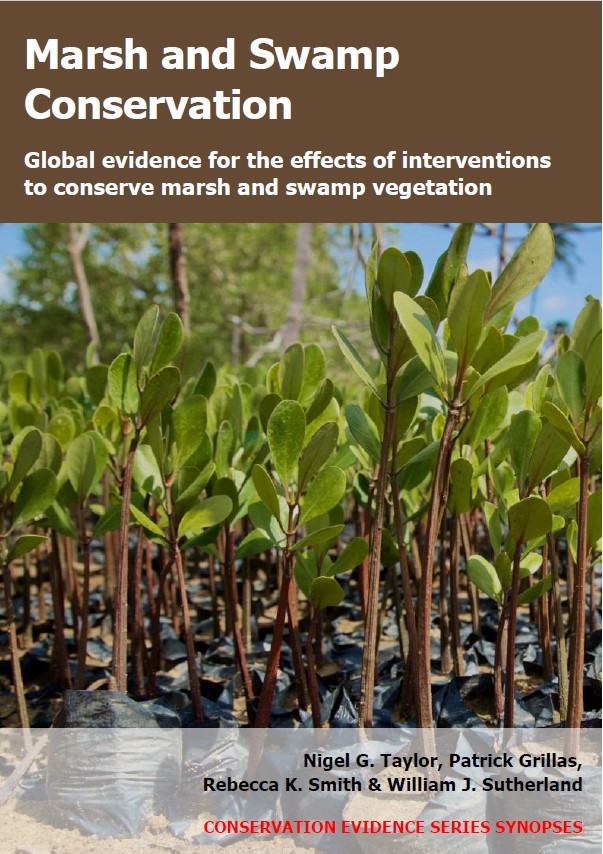Create mounds or hollows before planting non-woody plants: freshwater wetlands
-
Overall effectiveness category Unknown effectiveness (limited evidence)
-
Number of studies: 2
View assessment score
Hide assessment score
How is the evidence assessed?
-
Effectiveness
30% -
Certainty
32% -
Harms
10%
Study locations
Supporting evidence from individual studies
A replicated, randomized, paired, controlled study in 2012–2013 in a freshwater wetland in Wisconsin, USA (Doherty & Zedler 2015) found that creating mounds before planting tussock sedge Carex stricta did not improve survival rates, and typically had no significant effect on sedge growth, biomass or cover. After two growing seasons, survival rates were lower for sedges planted in mounds than on flat ground in seven of eight comparisons (for which mounds: 27–93%; flat: 100%). There was typically no significant difference between treatments in sedge growth rate (11 of 16 comparisons; see original paper for data). In three of the other five growth rate comparisons, all in the second growing season after planting, sedges grew faster in mounds (0.021–0.028 mm/mm/day) than on flat ground (0.013 mm/mm/day). In most cases, there was also no significant difference between treatments for final above-ground sedge biomass (four of four comparisons, for which mounds: 5–34 g/plant; flat: 7–39 g/plant) and final sedge cover (three of four comparisons, for which mounds: 11–46%; flat: 38–62%). Methods: In spring 2012, thirty 1-m2 plots were established, in six sets of five, in a wetland undergoing restoration. Soil mounds were built in 24 of the plots (five random plots/set). Mounds were either 8 cm tall, 16 cm tall, 16 cm tall with 50% woodchip, or 32 cm tall. The other six plots were left as flat ground. Five nursery-reared tussock sedges were planted into each plot (one plant/mound in plots with mounds) then regularly watered and weeded. Survival and above-ground biomass of planted sedges, and total tussock sedge cover, were surveyed in June–August 2013. Biomass was dried before weighing. Growth rates were calculated from leaf lengths measured in 2012 and 2013. This study used the same site as (2), but a different experimental set-up.
Study and other actions testedA replicated, randomized, paired, controlled study in 2013 in a freshwater wetland in Wisconsin, USA (Doherty & Zedler 2015) found that creating mounds or hollows before planting tussock sedge Carex stricta typically had no significant effect on sedge growth, biomass or cover, and reported that creating hollows reduced survival rates. After one growing season, sedges planted in hollows had a lower survival rate (63%) than sedges planted on flat ground (≥90%; data for mounds not reported; statistical significance not assessed). The treatments had no significant effect, compared to planting in flat ground, on sedge growth rate (mounds: 0.026–0.028 mm/mm/day; hollows: 0.032–0.035 mm/mm/day; flat: 0.027–0.035 mm/mm/day), final above-ground sedge biomass (g/plant; data not reported), or final sedge cover (six of six comparisons, for which mounds: 11–38%; hollows: 3–11%; flat: 15%). Methods: In spring 2013, twenty-four 1-m2 plots were established, in six sets of four, in a wetland undergoing restoration. Soil mounds (8 cm tall or 16 cm tall) were built in 12 of the plots (two random plots/set). Square hollows (10 cm deep; 15 cm across) were dug in six of the plots (one random plot/set). The final six plots were left as flat ground. Five nursery-reared tussock sedges were planted into each plot (one plant/mound or hollow where relevant). Survival and above-ground biomass of planted sedges, and total tussock sedge cover, were surveyed in June–August 2013. Biomass was dried before weighing. Growth rates were calculated from leaf lengths measured in 2013. This study used the same site as (1), but a different experimental set-up.
Study and other actions tested
Where has this evidence come from?
List of journals searched by synopsis
All the journals searched for all synopses
This Action forms part of the Action Synopsis:
Marsh and Swamp Conservation
Marsh and Swamp Conservation - Published 2021
Marsh and Swamp Synopsis





)_2023.JPG)














